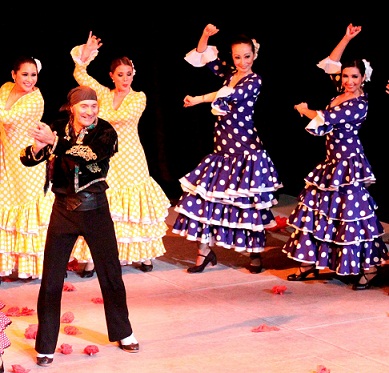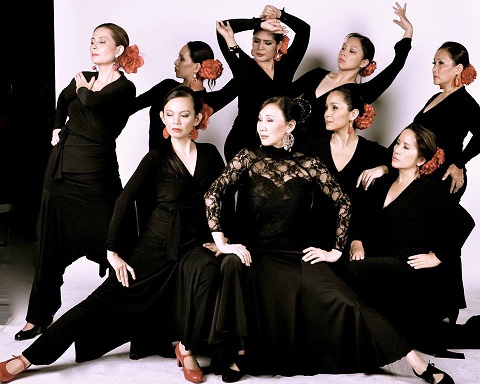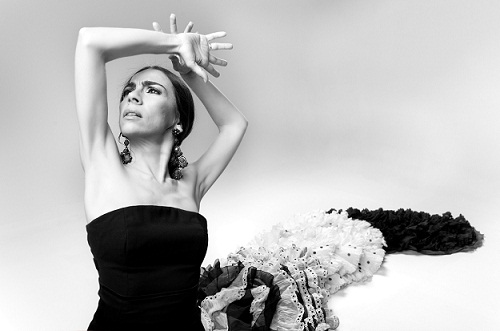By NORMAN SISON

THINK of Spain and you will most likely think of bullfights, paella, jamon — and, of course, flamenco.
The Spanish embassy in Manila delighted guests during its cent national day celebration with the performance of one of Spain’s most prominent artists in contemporary flamenco, Isabel Bayón, at Meralco Theatre.
To the cheers of “olé!” and palmas or handclaps from the audience in sync with the lightning-fast footwork that characterises flamenco, Bayón, a recipient of a Spanish national dance award last year, gave a performance that was a celebration of Spanish culture in all its richness.
Manila was the last stop of Bayón’s four-city Southeast Asian tour that also took her to Hanoi, Jakarta and Kuala Lumpur. A stop in Manila made perfect sense as the Philippines was Spain’s only presence in Asia for 300 years.
Among the audience at Meralco Theatre was Philippine Star lifestyle section editor Therese Garceau, who started taking flamenco lessons four years ago. “I first encountered flamenco by watching the recitals of my mom, who started taking flamenco over 10 years ago,” she said. “Every year I would watch the show and enjoy it immensely.”

The turning point came in 2009 during a family vacation in Spain. “We saw a flamenco show at Casa de la Memoria in Seville, and I just fell in love with it when I saw dancer Marta Arias, who was so graceful, powerful and strong,” Garceau said. “I wanted to be like her, and that’s when I decided that I would try to learn flamenco.”
Many Filipinos are familiar with flamenco, a legacy of Spanish colonial rule in the Philippines. However, in spite of Spanish influence in Filipino culture, Spain remains largely distant in the minds of Filipinos, who have more affinity for America.
Filipinos’ persistent image of Spain is that of Jose Rizal’s time at the turn of the 20th century, consisting mainly of venal Spanish Catholic priests and the brutal Guardia Civil paramilitary police. That stereotype image was immortalized in the Rizal novel Noli Me Tangere and its sequel, El Filibusterismo. The books helped set Filipino nationalism ablaze, culminating in the 1896 Philippine Revolution.
Garceau was surprised at the extent of Spanish influence in Filipino culture and how little she actually knew about Spain. “I rediscovered my love for Spanish culture through flamenco, which progresses from love of the dance to love of the language, food, and many other aspects of the culture,” she said. “I learned more about the Philippines as well, and how our colonial history with Spain shaped the culture that we have today.”
More and more Filipinos have been taking up flamenco over the years, observed Maria Emma Estrada, one of Garceau’s instructors or maestras. Estrada is the president of Fundacion Centro Flamenco (www.centroflamencophil.com), one of the country’s top flamenco academies.
It opens its doors to Spanish guest instructors and artists. One of them is Juan de los Reyes, who arrived in the Philippines a few years ago and is now married to a Filipina.

he Spanish embassy and the Spanish cultural center Instituto Cervantes de Manila promote flamenco as part of Spain’s efforts to reinvigorate ties with the Philippines and encourage Filipinos to rediscover Spain.
For one, flamenco opens a window into learning what the Spaniards are as a people. The dance is all about passion. Well, Spanish is said to be the language of romance — of course, the French will have something to say about that.
In traditional flamenco, young people are not considered to have the emotional maturity to adequately convey the duende or soul of the genre. Many flamenco dancers do not hit their peak until their thirties and will continue to perform into their fifties and beyond.
Bayón took 30 years to establish herself as a serious artist. Born in Seville, Bayón began lessons at the age of five. She earned her diploma in Spanish dance at the age of 16 after training at academies in Seville and Cordoba. Since forming her own dance company in 2001, she has created a series of choreographies that she has presented all over the world.
For Filipinos, to learn flamenco the way the Spaniards do is to let go of their characteristic hiya or shyness. “I think we can get there but it will take a long time because Filipinos are a very shy people. We have a different comportamiento (comportment). But definitely we have that Spanish sentiment, that Spanish influence in us,” she said, emphasizing that Filipinos are an amalgam of various ethnic and cultural influences that go back centuries.
Flamenco’s continuing evolution into a contemporary art form makes it more appealing to today’s generation. Ironically, Filipino affinity for America may also help as flamenco has been gaining popularity in the United States, where the Spanish language has also been growing.
“Flamenco is more associated with the youth while pasadoble is more with the older generation,” explained Estrada, referring to a ballroom-like dance that is still popular at town fiestas in the Philippines.
Well, in coming to terms with the past, it may help Filipinos to remember that the original definition of “Filipino” before the 1896 revolution was “a Spaniard born in the Philippines.”
“Filipinos should rediscover the passion and artistry that the Spanish have. We already inherited their love of dance and music,” said Garceau. “Oh, and maybe a siesta once in a while doesn’t hurt.”
